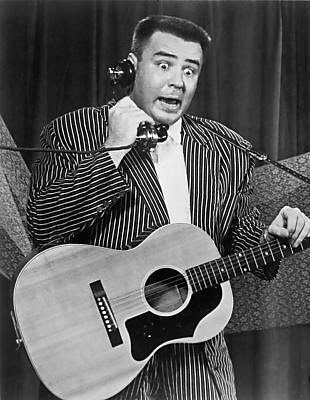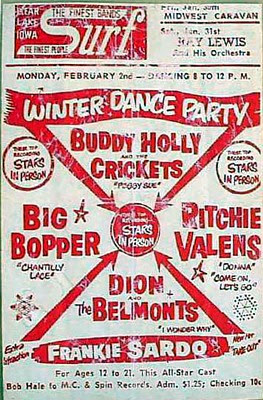I had two copies of this record, until I sold one of them to a man claiming to be the son of The Big Bopper. After asking him many questions, I am convinced that he was telling me the truth. He even invited me to attend one of his shows in northern Wisconsin. This man’s name was Jay Perry Richardson, and he was born two months AFTER the death of his famous father. He’s been performing as The Big Bopper Junior, doing concerts with a Buddy Holly impersonator named John Mueller, often on the same stages where his dad once performed with Buddy Holly.
He told me he’d been searching for a copy of this record for a very long time. He had a recording of it, but not the original vinyl pressing. According to him, the lady singing this song was actually his mother, Elise Richardson! Both sides of the record were written by The Big Bopper and published by Glad Music and Big Bopper Music.
Here’s Bopper 486609 by Donna Dameron (probably Elise Richardson) on Dart 113 from 1959:
And here’s the flip side of that single, a song called Big Love:
The Big Bopper’s father was born Jiles Perry Richardson on 12 October 1905 in Beaumont, Texas. In 1930, Jiles, then a 24 year old oil rig worker, married 20 year old Elise Stalsby. They had their first child, James Gilbert Richardson, on 28 October 1932 in Beaumont. James died on 12 December 1995 in Pasadena, Harris County, Texas.
The family moved to nearby Sabine Pass, Texas and had their second son, Jiles Perry Richardson Jr on 24 October 1930. He became known as The Big Bopper.
Sabine Pass in Jefferson County is a small town just on the Gulf of Mexico at the Louisiana-Texas border, about ten miles south of Port Arthur (birthplace of Janis Joplin) and 20 miles south of Beaumont.
A third child, Cecil Allen Richardson was born on 1 August 1934 back in Beaumont. He got married to Billie Carter and died on 30 August 1989 after living his entire life in Beaumont.
Jiles junior was nicknamed “JP” to distinguish himself from his father. His friends started calling him “Jape” instead. After he was born, the family moved back to Beaumont where JP graduated from Beaumont High School in 1947. He studied law at Lamar College while working a part-time job at KTRM radio. He joined the U.S. Army in 1955 and worked as a radar operator at Fort Bliss in El Paso, Texas. After being discharged, he returned to Beaumont and began working full-time at KTRM radio. A new dance craze called The Bop was really popular at the time, so he started calling himself The Big Bopper on his radio show. He had a passion for writing songs, and he soon became Program Director of the radio station. A couple of his early compositions would later become big hits, such as White Lightning and Running Bear.
A guy named Harold “Pappy” Dailey, who was Promotions Director for Mercury Records, heard The Big Bopper sing and offered him a contract with the label. His first recording, Beggar To A King, wasn’t very successful. He finally hit the big time with Chantilly Lace, which peaked at #16 on Billboard’s Hot 100 and stayed in the Top 40 for 22 weeks. All the while, he was still working at KTRM radio.
He took time off from that job to go on the road to perform with Buddy Holly And The Crickets, Ritchie Valens, and Dion And the Belmonts. The midwest concert tour, organized by the GAC agency, was called The Winter Dance Party. On the eleventh night of that tour, after finishing a show at the Surf Ballroom in Clear Lake, Iowa, Buddy Holly decided to charter an airplane to fly to the next show in Moorhead, Minnesota. He’d been traveling by bus for over a week, and it had already broken down once along the way. He was exhausted and his clothes were all dirty. Buddy’s plan was to arrive in Moorhead early enough to get his clothes washed and catch up on some badly needed sleep.
Roger Peterson, a 21-year old pilot, agreed to take the singers to the airport in Fargo, North Dakota, the nearest one to Moorhead. A blizzard was on the way, and Roger was tired after working a 17-hour day, but he agreed to make the trip anyway. Buddy Holly’s bass player, Waylon Jennings, was supposed to travel with them, but offered to give up his seat to The Big Bopper who was suffering with the flu at the time. Buddy yelled to Waylon, “I hope your ol’ bus freezes up!” Waylon shouted back, “Well, I hope your ol’ plane crashes!” That exchange would haunt Waylon Jennings for many years to come.
Buddy Holly’s guitarist, Tommy Allsup, flipped a coin with Ritchie Valens for the one remaining seat. Ritchie won that coin toss. Buddy Holly, Richie Valens, and The Big Bopper, climbed on board the red and white, single engine Beech Bonanza about 30 minutes past midnight on 3 February 1959.
Roger got clearance to take off from the tower, but was not warned that the blizzard was quickly approaching. Snow was blowing across the runway, but the sky still looked clear. Just a few minutes after taking off, the four-passenger plane crashed in an Iowa cornfield at over 220 miles per hour. It flipped over on impact and threw the passengers into the air. The bodies landed several yards from the wreckage and remained there for ten hours as big snow drifts formed all around them. Nobody could reach the crash site until the next morning.
Buddy Holly had just married Maria Elena six months before his death and she was pregnant at the time. She learned of her famous husband’s death from a news report on the radio. That traumatic experience probably contributed to her miscarriage shortly afterward. It was that incident that made it standard practice from then on to keep the names of victims from the press until after family members had been notified.
Here’s a recording of a radio news report that aired shortly after the accident:
I’ve personally visited the lonely spot where Buddy Holly’s plane crashed. I’ve also toured the Surf Ballroom at 460 North Shore Drive in Clear Lake, Iowa. If you have the chance to go there, I highly recommend it. It’s literally a museum of 1950’s music with the walls covered with records and memorabilia. Every year on the anniversary of Buddy Holly’s death, they have concerts there and a vinyl record show. The crash site itself can be difficult to find. It’s not marked very well, which has always seemed strange to me.
I can’t leave without sharing a couple tribute songs with you. This one is fairly well-known, having peaked at #11 on Billboard’s Hot 100 very shortly after the accident. This is Three Stars by Tommy Dee With Carol Kay And The Teen-Aires on Crest 1057 from 1959:
Here’s a much lesser-known tribute song that also came out just after the accident, but this one did not appear on the charts. Here’s Gold Records In The Snow by Benny Barnes on D 1052 from 1959:
You’ll hear this Donna Dameron single on MusicMaster Oldies, along with every song ever recorded by The Big Bopper, Buddy Holly and the Crickets, and Ritchie Valens, and literally dozens of tribute songs honoring these three legendary rock and roll pioneers. You’ll also hear plenty of great stuff from Dion and the Belmonts and even Waylon Jennings.
Every year some of my crazy friends and I take a 1000+ mile drive searching for places that are part of the history of rock and roll music. We particularly like to visit crash sites, which are often very difficult to find or located on private property. We like to find people from the area who were alive when the crash happened, interview them, and see if we can learn anything new. Just to give you an idea how crazy we are about this, we’ve already visited the crash sites of Ricky Nelson, Lynyrd Skynyrd, Otis Redding, Chase, Buddy Holly, Jim Croce, Stevie Ray Vaughan, along with dozens of other places. I’ll dig up our pictures and put some future posts together for you!
I like to think of MusicMaster Oldies as an ongoing tribute to the music of the 1950’s and 1960’s. It’s a musical museum you can visit any time you like!


